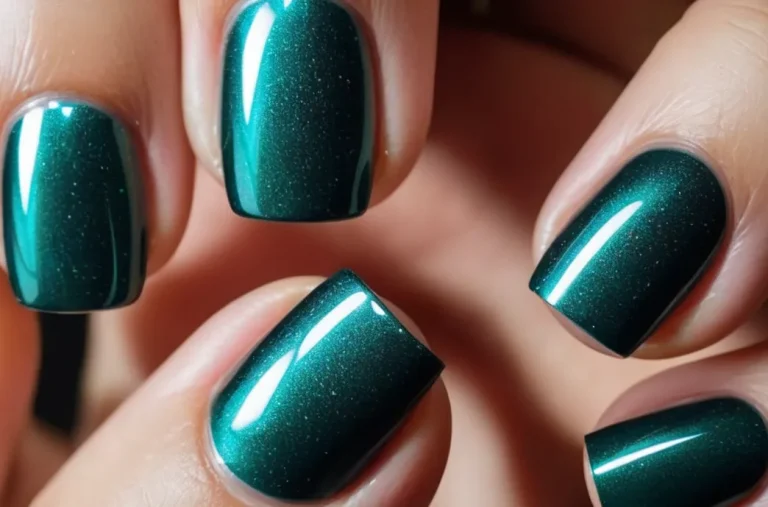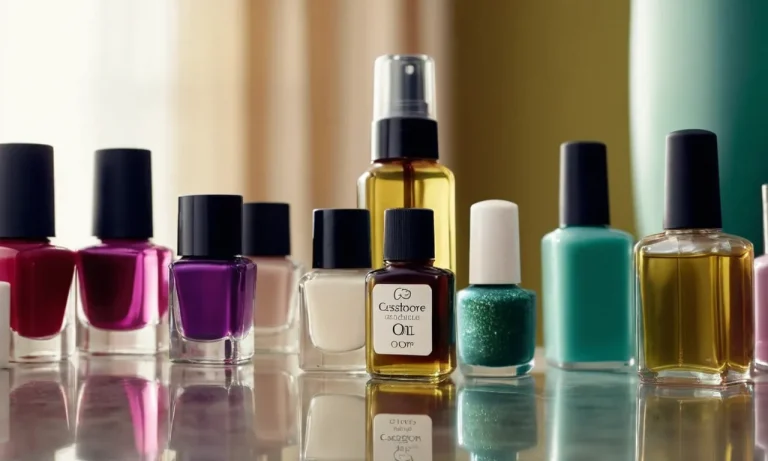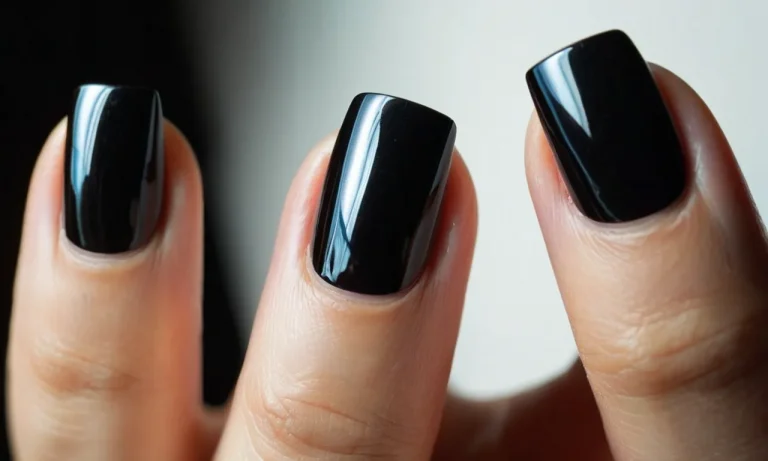Can You File Down Fake Nails? A Detailed Guide
Fake nails have become an incredibly popular way to get beautiful nails quickly without spending hours at the salon. But what happens when your fake nails start to lift or don’t fit your fingers properly anymore? Can you simply file them down to reshape them and make them last longer?
Read on to find out everything you need to know about safely filing your fake nails.
What Tools Should You Use to File Down Fake Nails?
Nail files designed for acrylics or gels
When it comes to filing down acrylic or gel nails, it’s important to use nail files that are designed specifically for these manicure types. Using regular emery boards can be too abrasive and cause damage to the artificial enhancements.
Look for professional-grade files made of materials like ceramic, crystal, or metal that have a fine grit of 180 or higher. The grit refers to the number of abrasive particles per inch on the file. The higher the number, the finer the grit and the smoother the finish.
Files with finer grits help shape and smooth artificial nails gently without being too harsh on the product or your natural nails underneath.
Acrylic and gel filing kits often come with multiple steps, like a heavy grit file for shaping, a medium grit buffer for smoothing, and a fine grit shine file for a glassy finish. This ensures you can perform all steps of the filing process with specially designed tools.
Using the proper grits is key – heavy files are meant for bulk removal and rough shaping while fine files refine the shape and create a polished look. Look for file brands like Young Nails or Nail Supply Glamour that cater specifically to artificial nail care.
Different grit nail files for shaping vs smoothing
When filing down acrylic or gel nails, it’s important to use files with different grits for the shaping and smoothing steps. Here’s a quick guide for choosing the right grit nail file:
- Coarse grits (80-120): Best for shaping and length removal. The rougher grit quickly eliminates excess length and product.
- Medium grits (150-180): Ideal for smoothing out ridges and imperfections after initial shaping.
- Fine grits (240+): Finest files that refine the shape and create a polished, glossy finish.
Trying to use a fine grit file to aggressively shape or shorten your artificial nails will take much longer and likely damage the product. Starting with a courser file prevents filing away too much length at first.
Then use medium grits to refine and smooth the shape before sealing the deal with a high grit shine file. Having a complete filing system allows you to work through each step with the right level of coarseness. Don’t forget to finish with a buffer for maximum shine!
Nail buffers for finishing touch
After filing acrylics or gels with graded grit nail files, don’t forget to buff! Buffing blocks help smooth out any minor ridges and seal the artificial material for a flawless finish. Made of soft cloth or foam, buffers gently remove the top layer of product to reveal a more even and polished look.
Use them after filing with 240+ grit files. Gently work the buffer over the entire surface of each nail to blend and seal. The buffing motion helps close up any porous areas in the artificial nail layer. Taking this final step helps fake nails look salon perfect!
Some other buffing block tips:
- Avoid buffing too much or applying too much pressure which can thin out the product layer.
- Use a 3- or 4-way buffer so you can buff in multiple directions.
- Look for buffers infused with fine grit for the smoothest results.
- Always use a light hand and buff gently to prevent heat damage.
- Buff every 1-2 weeks when nails start feeling slightly rough.
Investing in quality nail files and buffers specially designed for enhancements helps you safely file down acrylics, gels, or any other artificial nails. With the right tools and techniques, you can reshape, shorten, and smooth fake nails at home for a well-groomed look.
Tips for Filing Fake Nails Properly
Work slowly and gently
When filing down fake nails, it’s important to take your time and be gentle. Rushing through the process or filing too aggressively can damage the artificial nails or your natural nails underneath. Work slowly and use light, smooth strokes. Don’t rub back and forth quickly or apply too much pressure.
Take breaks if needed to avoid over-filing. Working patiently helps ensure you get the shape you want without weakening or thinning the nails. A gentle touch prevents cracking, chipping or peeling.
Shape one nail at a time
It’s best to file each artificial nail individually rather than trying to shape them all at once. Focusing on one nail allows you to tailor the filing to that specific nail’s needs. For example, you may need to file the edges more on one nail versus another to get the uniform shape you want across all nails.
Shaping one at a time also prevents you from over-filing since you can continually check and compare the shape against the other nails’ progress. Take your time with each nail until you achieve the desired look before moving onto the next.
Follow the natural curve of your nail
When shaping fake nails, it’s important to maintain the natural curve and contour of your actual nails underneath rather than filing straight across. Follow the existing shape of your nail bed as a guide. This helps prevent filing too much off the tip or sides of the nail.
If you file straight across, you risk thinning out the nail, exposing the natural nail underneath or creating an unnatural square shape. Plus, a straight-across shape won’t adhere as well to the natural nail.
Filing at an angle following your nail’s natural curve results in a more flattering, stronger and longer-lasting enhancement.
Smooth edges with buffer block
After filing your artificial nails into the desired shape, use a buffer block to smooth any rough edges. Buffing seals the edge and gets rid of any lingering sharpness for a clean finish. It also blends the transition between your natural nail and the false tip.
Run the buffer lightly over the top of the nail in one direction to refine the shape. Be careful not to over-buff as this can thin the nails. Use a very fine grit buffer designed for artificial nails. Check for any cracks or gaps between the false and natural nails and fill as needed with nail glue.
A smooth finish prevents snagging and lifts.
When Should You Avoid Filing Fake Nails?
Filing down those lovely, long fake nails can help maintain their shape and remove any rough edges. However, there are times when filing down artificial nails is not recommended. Here’s a guide on when you should avoid filing fake nails to keep them looking fabulous and avoid damage.
If nails are damaged, cracked or lifting
Filing down fake nails that are already showing signs of damage can exacerbate the problem. If your artificial nails are cracked, peeling, or lifting from the natural nail bed, any filing action can make these issues worse.
The friction from the nail file can cause more cracks or make existing ones larger. And if the bond between your natural nail and the acrylic or gel overlay is already compromised, filing can lift the artificial nail even more.
If your fake nails are damaged, it’s best to avoid filing them yourself and instead see a professional nail technician. They have specialized tools and products to remove damaged artificial nails and replace them with fresh overlays.
Filing damaged acrylics or gels at home will likely lead to greater lifting and eventually, losing the fake nail completely.
If you have injuries/cuts around nails
Filing down artificial nails should be avoided if you have any cuts, scrapes or hangnails around the nail bed. Even minor injuries to the skin around your nails can easily become infected or aggravated when you file fake nails.
The back-and-forth filing motion can disrupt scabs or healing skin, reopen wounds, and push bacteria deeper into cuts. This leaves you at greater risk for inflammation and infection around the nail.
It’s best to allow any nail bed injuries to fully heal before attempting to shape or thin your fake nails. The gentle friction of filing can also be painful if done over sore skin or cuts. Let those nail sidewalls completely heal before filing your acrylics or gels.
If too much product has been filed off already
There is such a thing as over-filing your artificial nails. If too much of the acrylic, gel or dip powder overlay has already been filed down, continuing to file can damage the natural nail underneath. Thinning fake nails excessively makes them weak and fragile.
This also allows oils from the nail bed to penetrate the remaining overlay more quickly, causing it to lift and peel away from the natural nail.
A good rule of thumb is to avoid filing off more than 1/3 of the original thickness of the artificial nail product. If your manicurist initially applied a fairly thick overlay, filing it down too much jeopardizes the bond and longevity of your fake nails.
It also increases the risk of cracks, breaks and losing the artificial nail completely. Let a professional assess if too much length or thickness has been removed when filing.
Filing artificial nails is a great way to perfect their shape and eliminate rough edges between salon visits. But overusing filing tools or filing damaged acrylics or gels can cause more harm than good. Knowing when to avoid taking a file to fake nails helps keep them looking their best.
Risks and Dangers of Improperly Filing Fake Nails
Can damage natural nails
Filing fake nails incorrectly can cause a lot of damage to your natural nails underneath. Here are some of the risks:
- Filing too aggressively can thin out the natural nail plate, causing it to become weak and peel or break easily.
- Using inappropriate tools like metal nail files or sanding bands can cause too much friction, heat damage, and scratches on the natural nail surface.
- Not properly smoothing edges after filing leaves microscopic ridges that snag on fabrics and tear at the natural nail.
- Filing side to side instead of in one direction can damage the nail fibers and cause splitting and peeling.
To avoid these issues, always use gentle pressure and high grit files made for artificial nails. Only file damaged edges instead of the entire surface, and use light strokes going in one direction. This helps maintain the integrity of your natural nails underneath.
Can cause cracks and lifting
Not filing nails properly can also lead to cracks, chips, and lifting of the acrylic or gel polish:
- Leaving sharp edges from poor shaping gives areas for splits and cracks to form.
- Applying too much pressure creates weakness that leads to chips and cracks.
- Filing off too much material thins areas that can start to lift and separate.
- Exposing and damaging the natural nail plate allows bacteria to get underneath and cause lifting.
Always shape free edges into smooth rounded curves and avoid over-filing surfaces. Use a soft finishing file to buff away any microscopic ridges left from coarser files. This helps prevent cracking and lifting problems.
Can increase risk of infection
Filing artificial nails incorrectly poses a high risk of bacterial and fungal infections:
- Too much friction and heat from bad filing techniques can damage the nail bed and allow infections.
- Splintered edges from poor shaping give more space for bacteria and fungi to enter.
- Reusing unsanitized nail files spreads microbes from client to client.
- Exposure of water to the nail plate allows bacterial and fungal growth.
Always use sterile, single-use files and sinks with running water during filing. Disinfect all tools between clients and avoid damage to the natural nail. Even microscopic gaps from poor filing provide an entry point for infections. Proper techniques are essential for client safety.
When to Seek Professional Help for Fake Nail Maintenance
For major reshaping or problems
There are a few instances when you should seek help from a professional nail technician for your fake nails:
- If you need to drastically reshape or change the length of your nails. Filing down acrylic or gel nails requires precision to avoid thinning them too much. Professionals have the proper tools and expertise.
- If your nails have cracked, broken, or completely popped off. Don’t try quick DIY fixes for major problems. Seeking professional help prevents further damage.
- If you notice signs of infection like swelling, redness, throbbing, discharge or excessive lifting of the nail. This requires medical treatment.
If you feel pain/discomfort
Filing or maintaining fake nails should never cause pain or discomfort. If you experience either, stop right away and make an appointment with your nail salon. Possible reasons include:
- Overfiling – This thins out the nail layers too much, causing sensitivity.
- Using tools that are too coarse – Gentler professional-grade tools are less likely to cause irritation.
- Lifting of nails from nail bed – This can catch on fabric and get worse. Needs to be rebonded.
Routine fills and maintenance
Though you can handle small touch-ups yourself, the average DIYer may not have the skills or tools for refilling grown-out nails or repairs. Things like:
- Fills for grown-out gel or acrylic nails every 2-3 weeks.
- Repairs for minor cracks, pops or breaks.
- Rebalancing uneven nail lengths or shapes over time.
Professionals also have access to higher quality nail products and can properly prep and prime the nail bed first. This enhances durability. Salon fills and maintenance visits typically range $25-$45 (source). Price varies by location.
Conclusion
While properly filing your fake nails can help maintain their shape between salon visits, it’s important to use the right tools and technique to avoid damage. Seek help from a professional nail technician if you experience any problems or need major adjustments.
With some care and caution though, light filing can keep your manicure looking tidy and well-shaped longer!







